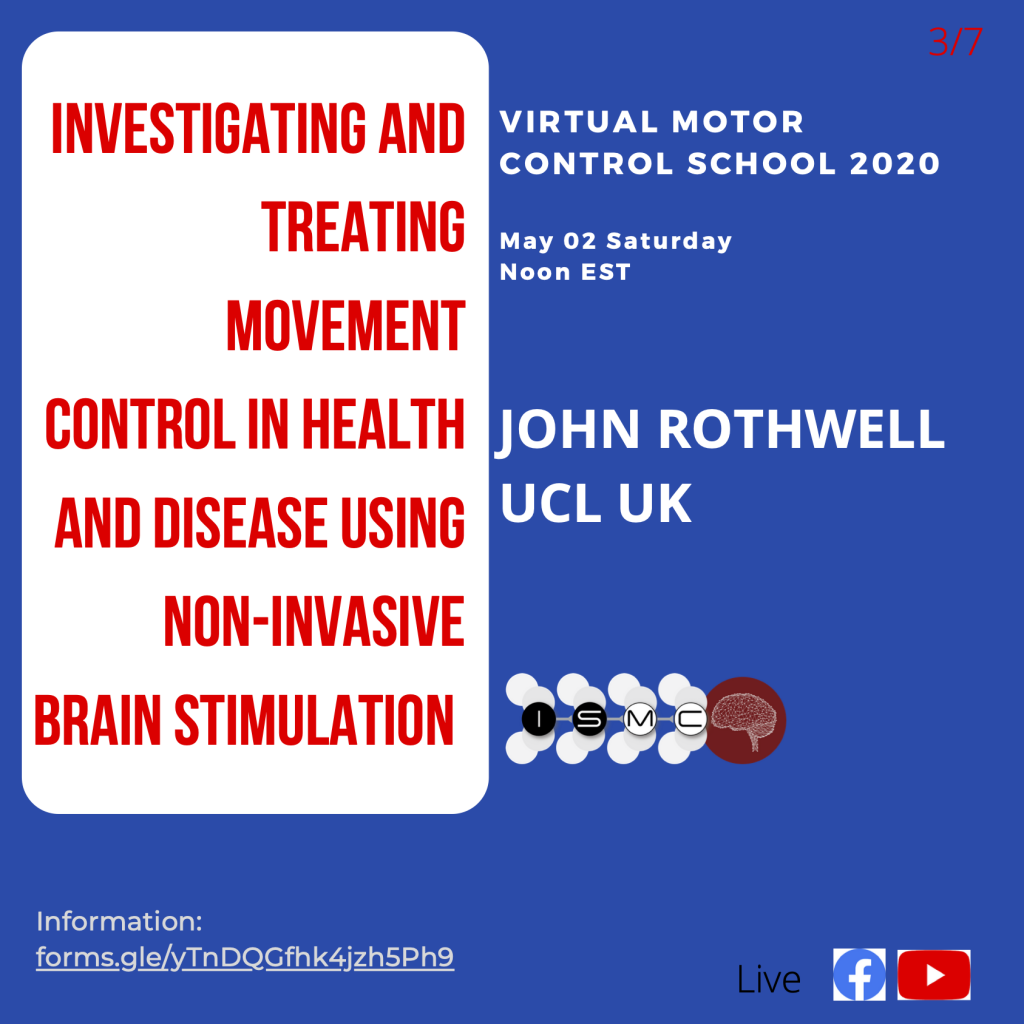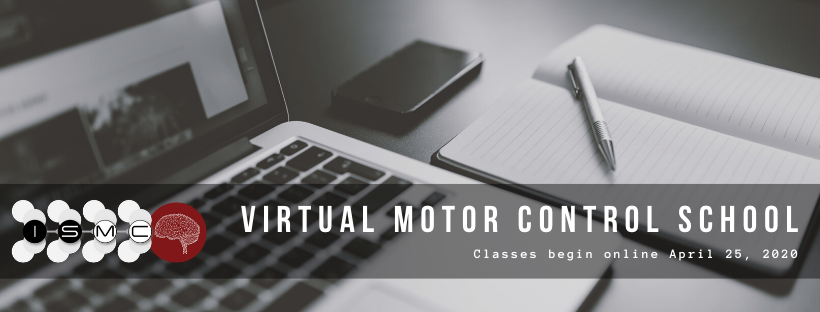Dear Friends,
In these challenging times, which make traditional Conferences next to impossible, we have decided to organize a series of lectures under the umbrella of Virtual Motor Control School (VMCS). The purpose of VMCS is similar to that of the Motor Control Summer School (MCSS) that has been running annually over the past 17 years. We hope to provide a forum for in-depth discussions of a variety of exciting and contentious issues in the field of motor control in a format that encourages discussions, frequent interruptions of the speaker, digressions, etc.
Each 1.5-hr-long session will feature one speaker, a group of “active participants” (former and future speakers) and an unlimited number of viewers (“passive participants”). Only active participants will be able to interrupt the speaker, ask questions in real time, digress, etc. We will use Zoom as the main platform, and sessions will be streamed in real time on YouTube.
Given the time zones, we plan all sessions to start at noon (Eastern US time zone), which corresponds to 9 a.m. in California and 5 – 7 p.m. in Europe (our apologies to colleagues in Asia, Australia, and New Zealand!). At this time, we plan to have two sessions each week, on Saturdays and Tuesdays.
Please confirm your registration by filling out the following form:
https://forms.gle/yTnDQGfhk4jzh5Ph9
The Virtual Motor Control Summer School has a Facebook page: https://www.facebook.com/groups/vmcss2020
To find the links for the live streaming, please visit the following links:
https://www.facebook.com/luis.mochizuki
https://www.youtube.com/user/mochizukil
Here is the schedule of sessions featuring speakers who were supposed to present at the cancelled MCSS in Slovenia in May 2020:
April 25 (Saturday):
Anatol Feldman, University of Montreal, Canada
Eye, head movements and vestibulo-ocular reflex revisited in the context of indirect, referent control of motor actions
Recommended readings:
Feldman A. G. (2015) Referent control of action and perception. New York, NY. Springer
Feldman A. G. (2019) Indirect, referent control of motor actions underlies directional tuning of neurons. Journal of Neurophysiology, 121, 3. 823-841.
https://doi.org/10.1152/jn.00575.2018
April 28 (Tuesday):
Mindy Levin, McGill University, Canada
Normal and disordered motor control – motor equivalence and adaptability during reaching tasks
Recommended readings:
Shaikh T, Goussev V., Feldman A.G., Levin M.F. Arm-trunk coordination for beyond the reach movements in adults with hemiparesis. Neurorehabilitation and Neural Repair, 2014;28(4):355-366. doi: 10.1177/1545968313510973. PMID: 24270057
Subramanian S.K., Baniña M.C., Sambasivan K., Haentjens K., Finestone H.M., Sveistrup H., Levin M.F. Motor-equivalent intersegmental coordination is impaired in chronic stroke. Neurorehabilitation and Neural Repair, 2020; 34(3):210-221. doi: 10.1177/1545968319899912.
Tomita Y., Mullick A.A, Levin M.F. Reduced kinematic redundancy and motor equivalence during whole-body reaching in individuals with chronic stroke. Neurorehabilitation and Neural Repair, 2018;32(2):175-186. doi: 10.1177/1545968318760725. PMID: 29554848
May 2 (Saturday):
John Rothwell, University College of London, UK

Investigating and treating movement control in health and disease using non-invasive brain stimulation
Recommended readings:
Latorre, A., Rocchi, L., Berardelli, A., Bhatia, K.P. & Rothwell, J.C. (2019). The use of transcranial magnetic stimulation as a treatment for movement disorders: a critical review. Movement Disorders 34, 769-782.
Davare, M., Kraskov, A., Rothwell, J.C. & Lemon, R.N. (2011). Interactions between areas of the cortical grasping network. Current Opinion in Neurobiology 21, 565-570.
Smith, MC. & Stinear, C.M. (2016). Transcranial magnetic stimulation(TMS) in stroke: ready for clinical practice? Journal of Clinical Neuroscience 31, 10-14.
Kumar, N., Manning, T.F. & Ostry, D.J. (2019). Somatosensory cortex participates in the consolidation of human motor memory. PLoS Biology doi:10.1371/journal.pbio.3000469
May 5 (Tuesday):
Jeroen Smeets, Free University, the Netherlands
How to move accurately: the case of grasping
Recommended readings:
de la Malla C, Brenner E, de Haan EHF, Smeets JBJ (2019) A visual illusion that influences perception and action through the dorsal pathway. Communications Biology 2:38 doi: 10.1038/s42003-019-0293-x
Smeets JBJ, van der Kooij K, Brenner E (2019) A review of grasping as the movements of digits in space. Journal of Neurophysiology 122:1578-1597 doi: 10.1152/jn.00123.2019
van der Kooij K, Smeets JBJ (2019) Reward-based motor adaptation can generalize across actions. Journal of Experimental Psychology: Learning, Memory, and Cognition 45:71-81 doi: 10.1037/xlm0000573
May 9 (Saturday):
Marco Santello, Arizona State University, USA
Sensorimotor integration and neural control of the hand: Behavioral, psychophysical and imaging approaches
Recommended readings:
Parikh P, Fine JM, Santello M (in press). Dexterous object manipulation requires context-dependent sensorimotor cortical interactions in humans. Cerebral Cortex. Cerebral Cortex, https://doi.org/10.1093/cercor/bhz296
Davare M, Parikh P,2 Santello M (2019). Sensorimotor uncertainty modulates corticospinal excitability during skilled object manipulation. Journal of Neurophysiology 121:1162-70.
Shibata D, Santello M (2017). Role of digit placement control on sensorimotor transformations for dexterous manipulation. Journal of Neurophysiology 118:2935-2943.
Fine JM, Moore D, Santello M (2017). Neural oscillations reflect latent learning states underlying dual-context sensorimotor adaptation. NeuroImage 15:93-105. doi: 10.1016/j.neuroimage.2017.09.026.
May 12 (Tuesday):
Gregor Schöner, Rühr University, Germany
The neural dynamics of movement generation
Recommended readings:
Schöner, G.,Tekülve, J., Zibner, S.K.U.: Reaching for objects: a neural process account in a developmental perspective. In: Reach-to-Grasp Behavior: Brain, Behavior and Modelling across the Life Span. Daniela Corbetta, Marco Santello (eds.),Tayler & Francis, (2019) pp 281-318
Martin,V., Reimann, H., Schöner, G.: A process account of the uncontrolled manifold structure of joint space variance in pointing movements. Biological Cybernetics 113(3), 293-307 (2019)
Reimann, H., Schöner, G.: A multi-joint model of quiet, upright stance accounts for the “uncontrolled manifold”-structure of joint variance. Biological Cybernetics 111(66) 389-403 (2018)
May 16 (Saturday):
Mark Latash, Penn State University, USA
Stability of action and perception
Recommended readings:
Latash M.L. (2017) Biological movement and laws of physics. Motor Control 21: 327-344.
Latash M.L. (2018) Stability of kinesthetic perception in efferent-afferent spaces: The concept of iso-perceptual manifold. Neuroscience 372: 97-113.
Reschechtko S., Latash M.L. (2017) Stability of hand force production: I. Hand level control variables and multi-finger synergies. Journal of Neurophysiology 118: 3152-3164.
Reschechtko S., Cuadra C., Latash M.L. (2018) Force illusions and drifts observed during muscle vibration. Journal of Neurophysiology 119: 326-336.
Cuadra C., Latash M.L. (2019) Exploring the concept of iso-perceptual manifold (IPM): A study of finger force matching tasks. Neuroscience 401: 130-141.
June 2:
Richard T. Nichols (Georgia Tech University, USA): Neuromechanical circuits of the spinal cord.
Nichols, TR (2018) Distributed force feedback in the spinal cord and the regulation of limb mechanics. J. Neurophysiol. (commissioned review). J. Neurophysiol. 119: 1186-1200. Dec 6:jn.00216.2017. doi: 10.1152/jn.00216.2017. [Epub ahead of print] PMID: 29212914. PMC5899305.
Lyle MA, Nichols TR (2018) Patterns of intermuscular inhibitory force feedback across cat hindlimbs suggest a flexible system for regulating whole limb mechanics. J. Neurophysiol. Nov 15:jn.00617.2017. doi: 10.1152/jn.00617.2017. [Epub ahead of print] PMID: 29142095. PMC5867384.
Ross, K.T. and Nichols, T.R. (2009) Heterogenic feedback between hindlimb extensors in the spontaneously locomoting premammillary cat. J. Neurophysiol. 101: 184-197. PMID 19005003.PMC2637003.
Nichols TR, Gottschall JS, Tuthill C (2014) The regulation of limb stiffness in the context of locomotor task. In: Progress in Motor Control IX. Levin MF (ed.). New York: Springer, pp. 41 – 54. PMID 25330884.
Nichols TR, Bunderson NE, Lyle M (2016) Neural regulation of limb mechanics: Insights from the organization of proprioceptive circuits. In: Neuromechanical Modeling of Posture and Locomotion, edited by Prilutsky BI, Edwards, DH Jr., Springer Serics in Computational Neuroscience, Ch 3: 69 – 102, New York: Springer.
Nichols, T.R. and Ross, K.T. (2009). The Implications of force feedback for the λ model. In: Progress in Motor Control V: A Multidisciplinary Perspective. Ed. Latash, ML. Champaign: Human Kinetics, pp 663-679.
June 6:
CJ Heckman (Northwestern University, USA): Identification of motor command structure from motor unit firing patterns, using supercomputer-based simulations.
Heckman CJ, Binder MD (1993) Computer simulations of motoneuron firing rate modulation. Journal of Neurophysiology 69: 1005-1008.
Binder MD, Powers RK, Heckman CJ (2020) Nonlinear input-output functions of motoneurons. Physiology 35: 31-39.
Johnson MD, Thompson CK, Yysseling VM, Powers RK, Heckman CJ (2017) The potential for understanding the synaptic organization of human motor commands via the firing patterns of motoneurons. Journal of Neurophysiology 118: 520-531.
June 9:
Robert Sainburg (Penn State University, USA): The neural foundations of handedness: Evidence from typical adults, unilateral stroke survivors, and a rare case of deafferentation
Yadav V, Sainburg RL. Handedness can be explained by a serial hybrid control scheme. Neuroscience. 2014 Aug 28. pii: S0306-4522(14) 00703-9. doi: 10.1016/j.neuroscience.2014
Woytowicz, E. J., Westlake, K. P., Whitall, J., & Sainburg, R. L. (2018). Handedness results from complementary hemispheric dominance, not global hemispheric dominance: evidence from mechanically coupled bilateral movements. Journal of Neurophysiology, 120(2), 729-740.
Schaefer SY, Mutha, PK, Haaland, KY, Sainburg, RL. Hemispheric specialization for movement control produces dissociable differences in online corrections after stroke. Cerebral Cortex. 2012; 22(6):1407-1419.
Maenza C, Good D, Varghese R, Winstein C, Sainburg RL. Functional Deficits in the Less-Impaired Arm of Stroke Survivors Depend on Hemisphere of Damage and Extent of Paretic Arm Impairment. Neurorehabil Neural Repair. 2020 Jan;34(1):39-50. doi: 10.1177/1545968319875951.
June 13:
Monica Perez (AbilityLab, Chicago, USA):
Altered Motor Control after Spinal Cord Injury: From Neurophysiology to Interventions
Benavides FD, Jo HJ, Lundell H, Edgerton VR, Gerasimenko Y, Perez MA. Cortical and Subcortical Effects of Transcutaneous Spinal Cord Stimulation in Humans with Tetraplegia. J Neuroscience, 40:2633-2643, 2020.
Jo HJ, Perez MA. Corticospinal-motor neuronal plasticity promotes exercise-mediated recovery in humans with spinal cord injury. Brain, 2020https://doi.org/10.1093/brain/awaa052
Sangari S, Lundell H, Kirshblum S, Perez MA. Residual descending motor pathways influence spasticity after spinal cord injury. Annals of Neurology, 86:28-41, 2019.
Vastano R, Perez MA. Changes in Motoneuron Excitability during Voluntary Muscle Activity in Humans with Spinal Cord Injury. J Neurophysiology, 123:454-461, 2020.
June 16:
Richard van Emmerik (University of Massachusetts, USA): Upper-body Coordination and Locomotor Control
Palmer, C.J., Van Emmerik, R.E.A., & Hamill, J. (2012). Ecological gait dynamics: stability, variability and optimal design. Footwear Science, 4(2), 167-182.
Remelius, J.G., Hamill, J. & Van Emmerik, R.E.A. (2014). Prospective dynamic balance control during the swing phase of walking: Stability boundaries and time-to-contact analysis. Human Movement Science, 36, 227-245
Van Emmerik, R.E.A., Wagenaar, R.C., Winogrodzka, A., & Wolters, E.Ch. (1999). Axial rigidity in Parkinson’s disease. Archives of Physical Medicine and Rehabilitation, 80, 186-191.
Wagenaar, R.C. & Van Emmerik, R.E.A. (2000). Resonance frequencies of arms and legs identify different walking patterns. Journal of Biomechanics, 33, 853-861
Weir, G., Van Emmerik, R.E.A., Jewell, C., & Hamill, J. (2019). Coordination and variability during anticipated and unanticipated sidestepping. Gait & posture, 67, 1-8.
June 20: Q & A

